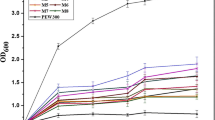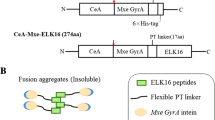Abstract
A novel antibacterial fusion protein, cecropin B-human lysozyme (CB-hLyso), was designed and expressed in a prokaryotic system. The full-length CB gene was first synthesized and fused to the 5′ end of the hLyso gene. The recombinant CB-hLyso was then subcloned in plasmid pET32a, and pET32a-CB-hLyso was transferred into Escherichia coli (E. coli) BL21(DE3) and BL21(DE3)pLysS. The results showed that in the original culture media, Luria-Bertani (LB) media and terrific broth (TB), at 37 or 25 °C, CB-hLyso was barely expressed; however, when the original culture medium was replaced with an equi-volume of fresh medium, obvious expression occurred in BL21(DE3)pLysS/pET32a-CB-hLyso at 25 °C, and the expression in TB (25%) was higher than that in LB (15%). Through a two-step chromatographic method consisting of Ni-chelated Sepharose Fast Flow affinity and Sephadex G-75 size-exclusion, the crude fusion CB-hLyso was isolated in a homogeneous form, and preliminary bacteriostasis experiments showed that the fusion CB-hLyso had a strong inhibitory effect on the growth of Staphylococci. This work provides useful insights into the design of novel fusion polypeptides with higher bacteriolytic activity and wider antimicrobial spectra and in the expression of polypeptide products that are toxic to prokaryotic host cells, eukaryotic host cells or insect cells.

Schematic representation of expression vector pET-32a-CB-hLyso, with Factor Xa and Asn-Gly.





Similar content being viewed by others
References
Alan AR, Earle ED (2002) Sensitivity of bacterial and fungal plant pathogens to the lytic peptides, MSI-99, magainin II, and cecropin B. Mol Plant-Microbe Interact 15:701–708
Bastos M, Bai G, Gomes P, Andreu D, Goormaghtigh E, Prieto M (2008) Energetics and partition of two cecropin-melittin hybrid peptides to model membranes of different composition. Biophys J 94:2128–2141
Bland JM, Lucca AJ, Jacks TJ, Vigo CB (2001) All-D-cecropin B: synthesis, conformation, lipopolysaccharide binding, and antibacterial activity. Mol Cell Biochem 218:105–111
Chiou PP, Lin CM, Perez L, Chen TT (2002) Effect of cecropin B and a synthetic analogue on propagation of fish viruses in vitro. Mar Biotechnol 4:294–302
Giacometti A, Cirioni O, Del prete MS, Paggi AM, D’Errico MM, Scalise G (2000) Combination studies between poly cationic peptides and clinically used antibiotics against Gram-positive and Gram-negative bacteria. Peptides 21:1155–1160
Holaskova E, Galuszka P, Frebort I, Oz MT (2015) Antimicrobial peptide production and plant-based expression systems for medical and agricultural biotechnology. Biotechnol Adv 33:1005–1023
Hu H, Wang C, Guo X, Li W, Wang Y, He Q (2013) Broad activity against porcine bacterial pathogens displayed by two insect antimicrobial peptides moricin and cecropin B. Mol Cell 35:106–114
Ibrahim HR, Matsuzaki T, Aoki T (2001) Genetic evidence that antibacterial activity of lysozyme is independent of its catalytic function. FEBS Lett 506:27–32
Jan PS, Huang HY, Chen HM (2010) Expression of a synthesized gene encoding cationic peptide cecropin B in transgenic tomato plants protects against bacterial diseases. Appl Environ Microbiol 76:769–775
Kaneko Y, Furukawa S, Tanaka H, Yamakawa M (2007) Expression of antimicrobial peptide genes encoding Enbocin and Gloverin isoforms in the silkworm, Bombyx mori. Biosci Biotechnol Biochem 71:2233–2241
Lata S, Sharma BK, Raghava GPS (2007) Analysis and prediction of antibacterial peptides. BMC Bioinf 8:263–273
Lee JH, Lee IH, Noda H, Mita K, Taniai K (2007) Verification of elicitor efficacy of lipopolysaccharides and peptidoglycans on antibacterial peptide gene expression in Bombyx mori. Insect Biochem Mol Biol 37:1338–1347
Manchenko GP (1994) “Lysozyme” handbook of detection of enzymes on electrophoretic gels. CRC Press, Boca Raton, pp 223–230
Mouro C, Gouveia IC (2016) Antimicrobial functionalization of wool: assessment of the effect of cecropin-b and [Ala5]-tritrp7 antimicrobial peptides. J TEXT I 107:1575–1583
Rocha EP, Danchin A (2004) An analysis of determinants of amino acids substitution rates in bacterial proteins. Mol Biol Evol 21:108–116
Sharma A, Sharma R, Imamura M, Yamakawa M, Machii H (2000) Transgenic expression of cecropin B, an antibacterial peptide from Bombyx mori, confers enhanced resistance to bacterial leaf blight in rice. FEBS Lett 484:7–11
Wang X, Zhu M, Yang G, Su C, Zhang A, Cao R, Chen P (2011) Expression of cecropin B in Pichia pastoris and its bioactivity in vitro. Exp Ther Med 2:655–660
Wang GS, Mishra B, Lau K, Lushnikova T, Golla R, Wang X (2015) Antimicrobial peptides in 2014. Pharmaceuticals 8:123–150
Yu F, Wang J, Zhang P, Hong Y, Liu W (2010) Fusion expression of cecropin B-like antibacterial peptide in Escherichia coli and preparation of its antiserum. Biotechnol Lett 32:669–673
Yu W, Gao XJ, Liu Y, Wang Q (2015) Fusion expression of cecropin b-like antibacterial peptide in pichia gs115 and its antibacterial mechanism. Biotechnol Lett 38:305–312
Zakharchenko NS, Rukavtsova EB, Gudkov AT, Yukhmanova AA, Shkol'Naya LA, Kado CI et al (2007) Expression of the artificial gene encoding anti-microbial peptide cecropin p1 increases the resistance of transgenic potato plants to potato blight and white rot. Dokl Biol Sci 415:267–269
Zhang M, Shan YL, Gao HT, Wang B, Liu X, Dong YY, Liu XM, Yao N, Zhou YG, Li XW, Li HY (2018) Expression of a recombinant hybrid antimicrobial peptide magainin II-cecropin B in the mycelium of the medicinal fungus Cordyceps militaris and its validation in mice. Microb Cell Factories 17:18–32
Funding
This work was supported by a grant from the National Natural Science Foundation of China (Grant 21075097).
Author information
Authors and Affiliations
Corresponding author
Ethics declarations
Conflict of Interest
The authors declare that they have no competing interests.
Additional information
Publisher’s Note
Springer Nature remains neutral with regard to jurisdictional claims in published maps and institutional affiliations.
Electronic Supplementary Material
ESM 1
(PDF 310 kb)
Rights and permissions
About this article
Cite this article
Zhang, Y., Li, Y. & Bian, L. Design and Unique Expression of a Novel Antibacterial Fusion Protein Cecropin B-Human Lysozyme to Be Toxic to Prokaryotic Host Cells. Probiotics & Antimicro. Prot. 11, 1362–1369 (2019). https://doi.org/10.1007/s12602-019-09527-8
Published:
Issue Date:
DOI: https://doi.org/10.1007/s12602-019-09527-8




